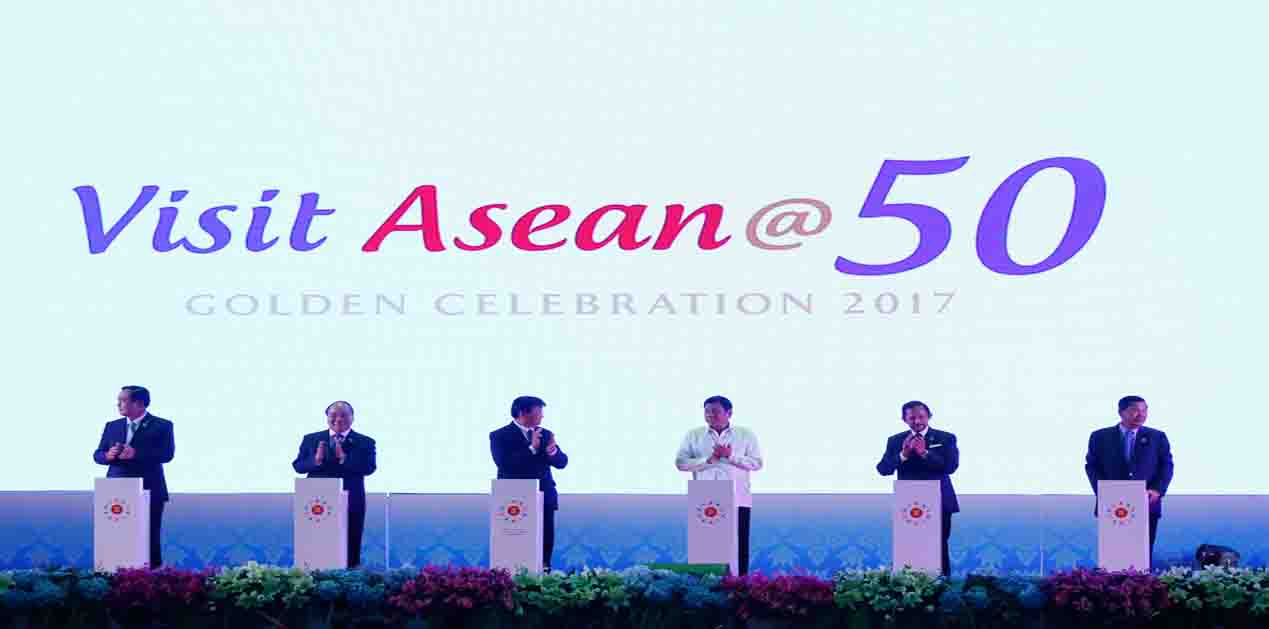The concept of Association of Southeast Asian Nations’ (ASEAN) centrality has been much talked about as being one of the most cherished principles of the multilateral organization; however, there is no clear or detailed definition of the term. Yet the underlying theme or implicit in this concept is ASEAN’s ability to shape and influence the decisions that affect the organization and its members and also facilitate solutions. The South China Sea dispute has been one such issue where the members of ASEAN have been unable so far to present an integrated approach due to a variety of reasons ranging from narrow national interests to different foreign policy orientations. Such weaknesses of the ASEAN platform are bound to be exploited by a rising hegemonic and imperial power like China who continues to expand its core interests and continually changes the status quo.
Undoubtedly, ASEAN has responsibility to protect its economic, security, environmental and a variety of other interests and therefore, it is expected to meet challenges posed to such interests. A divided house would offer opportunities to the predatory power in realizing its long term designs in the region. China through its economic and military heft has been able to influence adversely the unity of ASEAN through economic inducements or otherwise. While ASEAN has strived to achieve regional integration through a number of joint endeavors such as formation of ASEAN Community, which comprises of ASEAN Economic Community (AEC), ASEAN Political-Security Community (APSC), and ASEAN Social-Cultural Community in addition to many other efforts in this direction, yet the South China Sea dispute presents a challenge to ASEAN unity.
During the 30th ASEAN Summit held in Manila in end April the Chairman’s statement reaffirmed the importance of maintaining peace, stability, security and freedom of navigation and over-flight in and above the South China Sea. He also shared concerns of the ASEAN members regarding the recent developments in the South China Sea and underscored the importance of the full and effective implementation of the Declaration on the Conduct of Parties in the South China Sea (DOC) in its entirety. While China has promised to complete a framework of the Code of Conduct in the South China Sea (COC) by middle of this year, in order to facilitate the early conclusion of an effective COC but it is anybody’s guess whether the same will fructify in any meaningful manner in an early timeframe given the nature of China’s tactics of delaying the same inordinately since 2002. The Vietnamese Prime Minister Nguyen Xuan Phuc, while speaking at the ASEAN Summit, shared the common concern about recent developments in the international and regional situation, which left multi-dimensional impacts on ASEAN and each member nations. He stressed that the challenges are also an opportunity for ASEAN to prove its capacity and central role in addressing regional issues. He was of the firm opinion that ASEAN should promote the basic principles and common stance on solving disputes by peaceful measures in line with international law, especially the UN Convention on the Law of the Sea, 1982 (UNCLOS 1982).
In May 2017 China also came out with a white paper on Vision for Maritime Cooperation under the Belt and Road Initiative (BRI). The starting place for the vision is the South China Sea littoral and has number of implications for the region. While the whole paper is peppered with blue economy, cooperation and benefits to be derived from sustainable development yet, the central locus of the paper revolves around promoting ‘the concept of common maritime security’. Though, the paper talks about enhancing maritime cooperation on non-traditional security issues it is also clear and apparent from this paper that under the cloak of non-traditional security China will expand its hard power projection capabilities. The new maritime vision calls for upholding the existing international ocean order but China’s own behavior in rejecting the Permanent Court of Arbitration (PCA) award of July 2016 on dispute with Philippines does not inspire much confidence that it would follow international norms. Militarization of islands and reefs in South China Sea leading to destruction of diverse marine biodiversity and negatively impacting the environmental balance does not create a positive climate for accepting the intentions articulated in this latest Chinese paper on maritime vision. In addition to the environmental concerns such activities also impact adversely the economic interests and civilian security in the maritime domain. There have been a number of attacks against fishermen in the South China Sea and there is no system for maintaining any records are for investigation or established procedures for dealing with such incidents. This is an area where ASEAN has assert its centrality and formulate solutions to such like issues.
China has continued with its militarization activities after the PCA award; it has built four new missile shelters in disputed islands in the South China Sea reflecting its continued violation of the international norms. Besides constructing four shelters for missiles at Fiery Cross Reef, its military has also expanded communications and radar capabilities. Further, China has also embarked on increasing the ‘civilian presence’ through tourism, cruises, building of infrastructure for tourism, increasing the civilian population in the disputed islands with the aim of further consolidating its claims and hold over the disputed islands in the South China Sea. Additionally, China has been gradually and very subtly changing its position on the questions and principles of territorial sovereignty and following international norms. While in its paper on China’s Policies on Asia Pacific Security of January 2017 it declares its adherence to “the purposes and principles of the Charter of the United Nations, the fundamental principles and legal system defined by universally recognized international laws and modern maritime laws, including the UNCLOS and the Five Principles of Peaceful Coexistence” the mention of UNCLOS is altogether absent in Joint Communiqué of BRI of May 2017 or for that matter Vision for Maritime Cooperation of June 2017.
While President Trump might have pulled out of the Trans Pacific Partnership agreement the major elements of ‘Rebalance to Asia’ by the US and its politico-strategic approach to Asia-Pacific have not undergone any major change. The bilateral equations with the countries of ASEAN and East Asia are still in place and are becoming robust because of China’s assertive and irredentist policies on its periphery. Further, though, there was a considerable pause in conducting Freedom of Navigation Operations (FONOPS) in the South China Sea the first such patrol during Trump’s era was carried out by the US Navy sailing within 12 nautical miles of a Chinese artificially built island in May this year.
Though the ASEAN talks about the centrality of the ASEAN in its regular annual summits and ministerial level meetings China has been able to divide the ASEAN with its economic inducements and developmental projects including building of infrastructure through the instrument of BRI. Cambodia and Laos remain firmly in China’s camp and some other countries like Indonesia adopt relatively neutral stance on the contentious issues especially of the South China Sea. However, Cambodia could also have a debt crisis at its hand given the nature of Chinese loans extended to it by China. Even though Philippines won its arbitration case regarding its Scarborough Shoal dispute with China on the SCS President Duterte chose to ignore the findings of the PCA and cozied up to China partly influenced by the fact that Beijing could offer hefty economic package. Duterte, after attending the Belt and Road Forum in mid-May 2017, also said that BRI complements ASEAN integration. Indonesia has also been keen to derive benefits from the BRI but it also wants to offer such projects to Japan and the United States which have major interests in the growth of this region. Interestingly, asserting its nationalistic stance Indonesia has recently come out with a map renaming the sea around Natuna Island as North Natuna Sea which has not gone down very well with the Chinese.
India, on its part, has supported the right of freedom of navigation and overflights and unimpeded commerce across the South China Sea based on international law, as reflected notably in the 1982 UN Convention of the Law of the Sea (UNCLOS). Prime Minister Modi in his address at the 11th East Asia Summit (EAS) had stated that “As a State party to the UNCLOS, India urges all parties to show utmost respect for the UNCLOS”. ONGC has also accepted extension of an existing concession by Vietnam in the South China Sea and begun drilling in another area located totally in the EEZ of Vietnam in the South China Sea. Recently, Foreign Minister of Australia was in India to strengthen cooperation in Indo-pacific region. She said that Australia was opposed to militarization of the SCS.
The SCS dispute presents one of the most dominating challenges to the ASEAN unity and its amorphous concept of centrality. The gains made by ASEAN in last over five decades of its existence could fritter away if any outside power is able to fracture its unity. ASEAN as an organization has stressed so far on conflict management with China rather than conflict resolution. There is also a case for finding the way forward with China on the question of South China Sea under the Treaty of Amity and Cooperation to which China and many other countries subscribe to besides the ASEAN.
Image Source: http://www.rappler.com/world/specials/southeast-asia/asean-journey/167868-schedule-asean-summit-april-26-29











Post new comment